
10 minute read
WE NEVER STOPPED WORKING’ We discover how NSRI has adapted to the new normal
WORKING WE NEVER STOPPED WORKING
A behind-the-scenes look at how the NSRI’s training, drowning-prevention and rescue response continued operating during the Covid-19 lockdown. By Wendy Maritz
FROM 27 MARCH to 26 August this year, Besides Stewart, other role players included Sea Rescue conducted 269 operations. NSRI CEO Dr Cleeve Robertson, Class 1 coxswain Among these 46 were medevacs, 20 were and surgical registrar Dr Tomé Mendes, and animal rescues, 44 were tows and a total of 202 operations manager Brett Ayres. Between them persons in distress were assisted. Continuing to they studied numerous peer-reviewed research operate during the national lockdown was never papers and liaised with national and international in question for NSRI volunteers and staff, but organisations. ‘We spent hours day and night keeping crew and casualties safe had to be a pribefore and after the lockdown announcement ority, as was maintaining crew training and conto understand the behaviour of Covid-19 so that sistently delivering to vulnerable communities the we would be on top of keeping the crews safe. vital drowning-prevention education messages As doctors and ALS paramedics, the use of fullthat have gained such tremendous momentum. body PPE for infectious diseases is not new to With the onset of social distancing, stay-at-home us, so we were able to use a combination of our orders and school closures, and considering the collective medical and rescue experience along particular voracity with which Covid-19 spreads, it with recommendations from the Centers for all just had to be done in a different way. Disease Control and Prevention, the World Health Organization, the National Institute for Comm nicable Diseases and national government to put together protocols specific to our operations.’
DEVELOPING STANDARD OPERATING PROCEDURES
NSRI’s Lifeguard training coordinator and adStewart observes that the rescues that operavanced life support (ALS) paramedic Stewart Seini tions crew need to perform are complex enough, describes how the NSRI went on high alert several requiring swift mobilisation and split-second weeks before the hard lockdown was announced. decision-making, and adding an extra layer to At the time, the Lifeguard Unit, which was undergothese operations by way of standard operating ing training, was present and on duty on crowded procedures (SOPs) needed to be done in a spebeaches. ‘Overnight, we had to change first-aid cific way. These procedures had to be extensive protocols, rescue protocols and procedures for enough to keep crew safe yet easy to implement our Lifeguard stations to follow.’ Stewart began by in an emergency situation. Separate guidelines were created for crew who might
The rescues that operations crew perform are come into direct contact with highcomplex enough, and adding an extra layer risk patients, for example during a needed to be done in a specific way. medevac, and for those encountering non-high-risk patients. distributing a series of videos outlining basic PPE ‘With suspected or confirmed Covid-19-positive procedures and patient treatment protocols to all casualties, a smaller but highly qualified senior the station commanders. These were the initial team will respond,’ Stewart explains. ‘And each steps, while behind the scenes a task force was one of those members has a well-defined role for formed to ‘research and liaise with national and inthat operation. This has been done to keep the ternational agencies so that our organisation could rest of the crew safe so that they could be tagged have the best protocols in place’, Stewart explains. in if any of the current operational crew have to
be removed due to exposure. We also introduced a PPE safety officer whose sole responsibility is monitoring, guiding and protecting the rescue crew and healthcare providers through the protocols of the don and doff procedures relating to PPE.’
In respect of medevacs, a screening process was introduced outlining a series of questions specific to Covid-19 that would help establish the level of risk involved and the safest way to bring the casualty to safety. For each medevac the following questions were considered: 1/ Is the patient’s condition stable enough for the rescue vessel (with a medical crew ready to board at a moment’s notice) rather to follow or escort the vessel back to the closest and safest port? 2/ Does the patient’s condition warrant the boarding of a medical crew? If so, medics will board with high-risk PPE. 3/ Does the condition of the patient warrant a transfer to the rescue boat or can they instead continue to the nearest and safest port with only the medics on board?
Stewart adds that it was equally important during these unprecedented times, when there is so much fear around the unknown that is Covid-19, that volunteers continued to treat all casualties with compassion. Empathy and care remain the hallmarks of the NSRI’s dedicated crew.
TRAINING ADJUSTS TO A NEW NORMAL
NSRI volunteers are highly skilled individuals who undergo rigorous fitness training as well as more specific operational training that covers navigation systems, procedures to follow for maritime extrication (medevacs), swift-water and air-sea rescue, as well as leadership instruction by way of its coxswain assessment course. In recent years the establishment of the Lifeguard Unit has meant a growing presence of trained crew on duty at beaches too.
NSRI’s head of training and development Graeme Harding explains that while the operational aspects of crew training take place at the NSRI’s Cape Town-based training centre, theory training (from trainee to coxswain level) is conducted via its e-learning platform, and practical development courses are held at stations countrywide, facilitated by NSRI’s training department.
Face-to-face interaction provides much of the motivation, sharing and camaraderie among peers essential to effective learning in any sector. So how, during the first few months of the lockdown, did the training department adapt? Graeme admits that the biggest consideration when
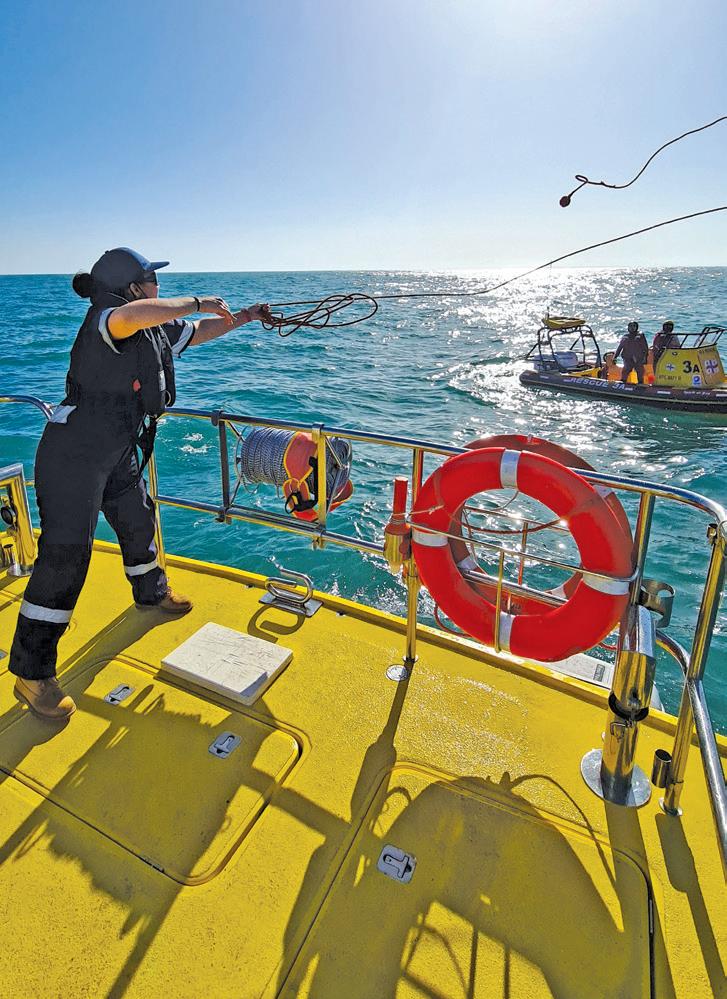
Training during lockdown.
taking all learning virtual was to keep the crew’s motivation and best interests in mind. They were ahead of the curve, had anticipated that the hard lockdown was imminent and had set up a Facebook page a couple of weeks prior to the announcement. ‘It would be the easiest way to stay in contact with everyone,’ he says. Within three days 80% of the crew had joined the page.’
One of their great successes, Graeme explains, was the masterclasses they set up. ‘These covered various subjects pertinent to what we do, as well as the required training. They were also interactive, which allowed for valuable question-and-answer sessions. For those unable to attend, recordings were made and posted to the site. At the moment there is a total crew attendance of 2 500 crew across all the masterclasses.’
In addition, a series of videos was made with the crew, covering navigation, maritime emergency care, fitness and stress management, among a host of other subjects. The result has been that ‘crew morale is high, and the communication has brought us together even more’, he says. ‘We feel it’s definitely created a closer community.’
While some ‘normal’ training has commenced, the training department is poised to hear what Level 2 of the lockdown will bring. Reducing the risk of exposure for crew remains paramount. Graeme says the latest virtual training will definitely be integrated with live training as the former has been so successful.
‘One of the biggest positives during this period is the buy-in from crew when it comes to this kind of training. It has been phenomenal and we are extremely grateful for the passion and commitment shown by this extraordinary group of volunteers. We salute them!’

LOCKDOWN TRAINING WITH STEWART
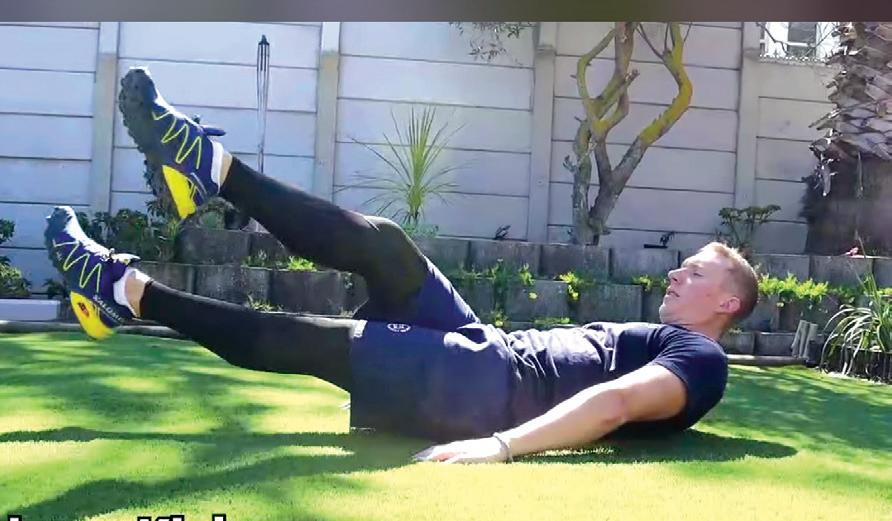
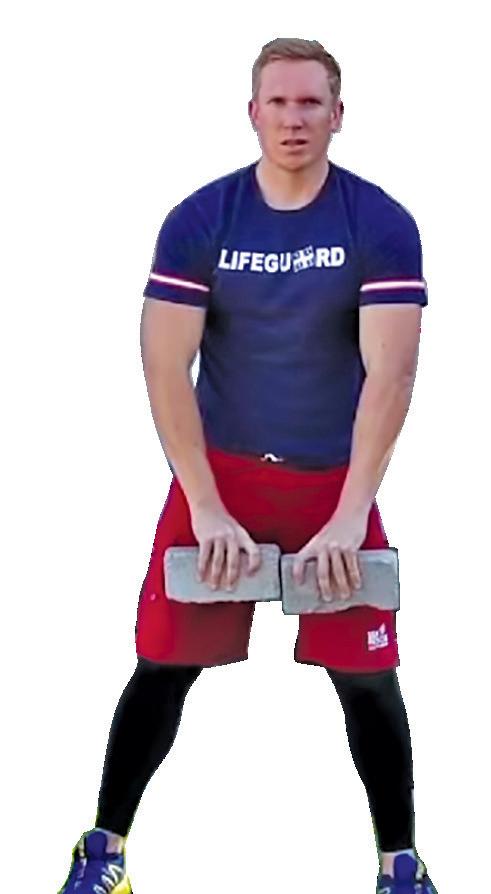
During lockdown Stewart Seini’s daily fitness videos have become somewhat legendary. Head of Drowning Prevention Andrew Ingram approached Stewart to develop a fitness programme for his team. Stewart decided on fitness videos so he could demonstrate the correct techniques. The exercises could be done at home easily, with no equipment required. Stewart was perhaps not prepared for how popular the programme would become, but it’s safe to say that it was not only crew but also supporters who followed his instructions.
‘We call them bodyweight exercises,’ Stewart explains, ‘and the series was initially meant to last 21 days.’ In the end, more than 100 videos were made, and they progressed from the NSRI Facebook training page to the public page. The project even got a mention on KFM!
‘The feedback I received was incredible. I had members and station commanders from all over the country messaging me to tell me about their progress and transformation – and their sore muscles. Families were getting together to exercise and I found out that international rescue organisations were following the fitness videos. I didn’t expect they would create such an impact. It was truly humbling.’ Go to www.bravobravo.co.za to access Stewart’s training series.

DROWNING-PREVENTION EDUCATION GOES VIRTUAL
Andrew Ingram, head of Drowning Prevention at NSRI, shares how water-safety education adapted during South Africa’s lockdown. On 26 March 2020 South Africa went into lockdown Level 5, and for Sea Rescue’s water-safety team it was the end of face-to-face teaching in schools. Our plan to reach 600 000 children with our water-safety lessons was blown out of the water by President Ramaphosa on 23 March. Schools were closed. The team had taught just more than 127 000 children, and we needed to find new ways of getting our safety messages out into the communities where they were most needed.
At first, under Level 5 and Level 4 of the lockdown, the number of drownings dropped remarkably – so much so that we are going to have to mark 2020 drowning statistics with an asterisk when reviewing them in future. However, as the lockdown was relaxed, people started venturing out. The terrible accounts of children drowning once again started appearing in media reports.
Between 12 June and 19 July various media houses reported on three double drowning incidents. Six children had drowned because of failed peer rescue attempts: Nomswenko, 18, and ABOVE: Watersafety instructor Kim Abrahams gives an online lesson. RIGHT: Drowning victim Loveness Sibashe’s father, Enos, is responsible for two Pink Buoys at Mabulala Dam.
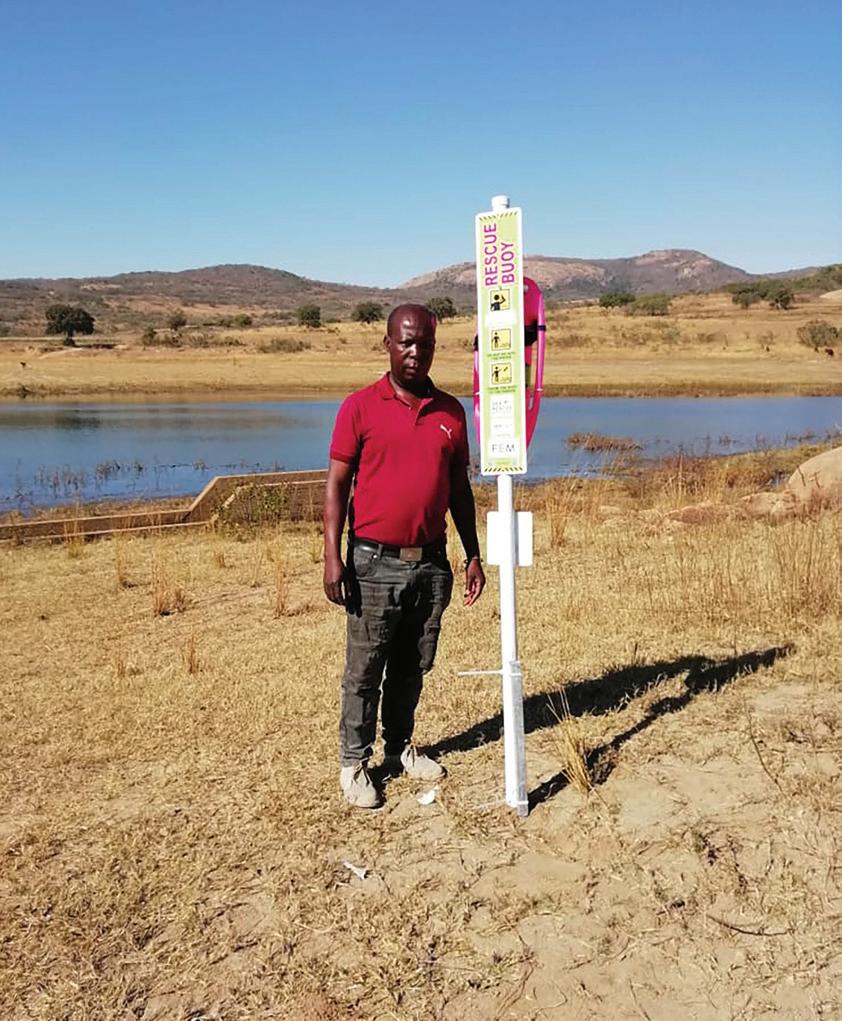
Loveness, 15, drowned in Mabulala Dam near Hazyview in Mpumalanga; Abieda, 8, and a man who tried to help her drowned in a canal in Belgravia, Cape Town; and Damien, 7, and his sister Kyli, 5, drowned in a dam near Gansbaai. Then 10-year-old Jay-den was swept off the Gansbaai harbour wall. None of these tragedies should have happened. They were all preventable.
As a department, we had already pivoted and were focused on digital water-safety education. Our 21 instructors had, almost overnight, become confident to be interviewed on radio about general water safety. A few had even secured television interviews. With the help of our team leaders and the accurate fatal drowning statistics that we have built up, we targeted messages at the relevant communities in their home languages.
We sent safety messages via as many platforms as possible, with a strong focus on WhatsApp, Facebook and local radio stations.
We identified local community leaders who
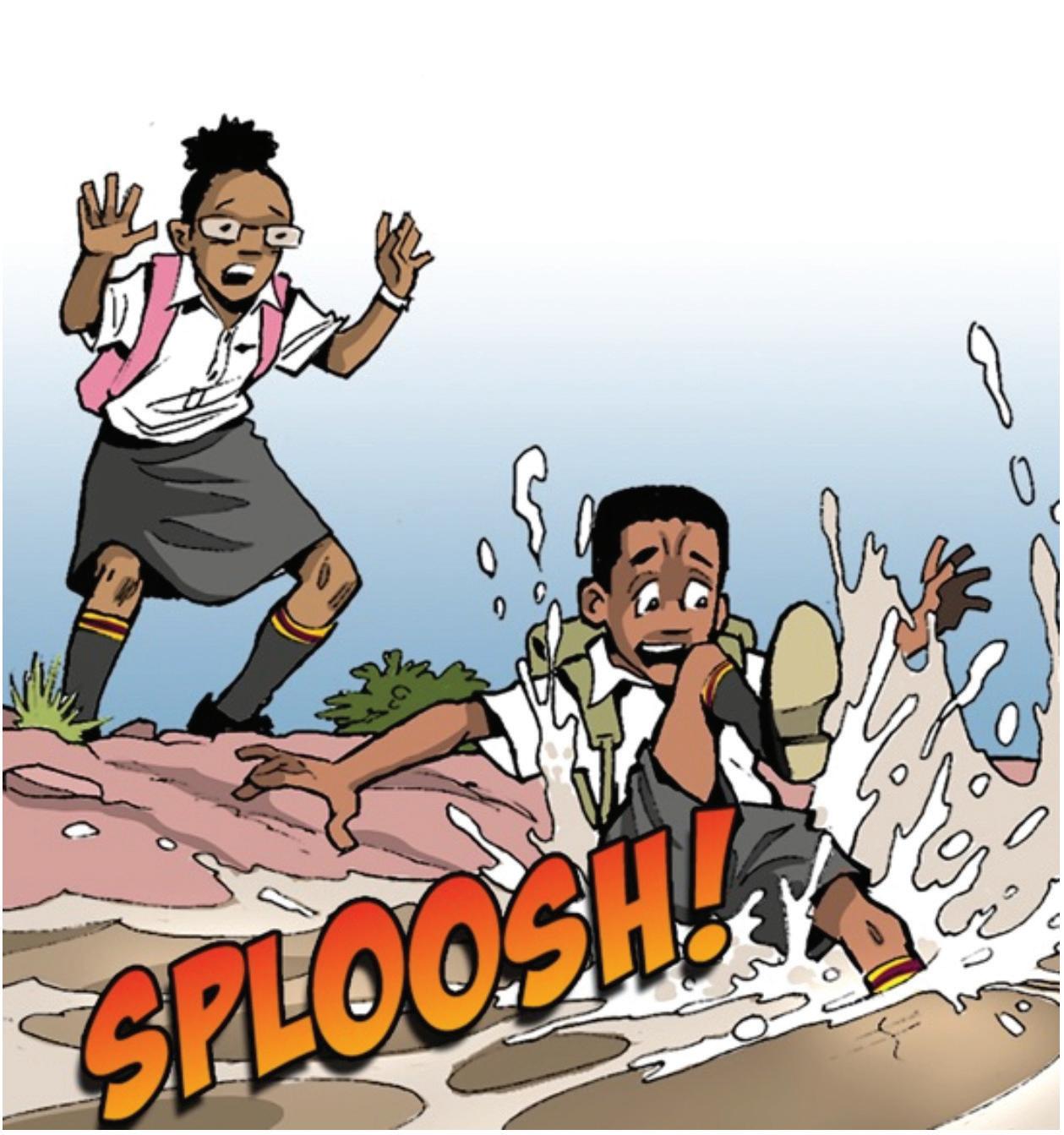

LEFT: Sea Rescue water-safety stories were repurposed and published on African Storybook, a digital platform for children’s stories.
would install and monitor Pink Rescue buoys; we did radio talks about the danger of peer rescue, how to help someone in difficulty in the water and who to call for help; and we posted short video-clip messages from our instructors in local languages on WhatsApp and Facebook.
In a few short weeks, the drowning-prevention team, a unit that specialised in face-to-face teaching, had honed their digital skills to keep spreading the word. With cellphones and PCs we are now carefully targeting communities that are at risk and getting water-safety messages to those who need them the most with video, graphics and pictures that tell a thousand words. It’s what we do. And Covid-19 is not going to stop us.










